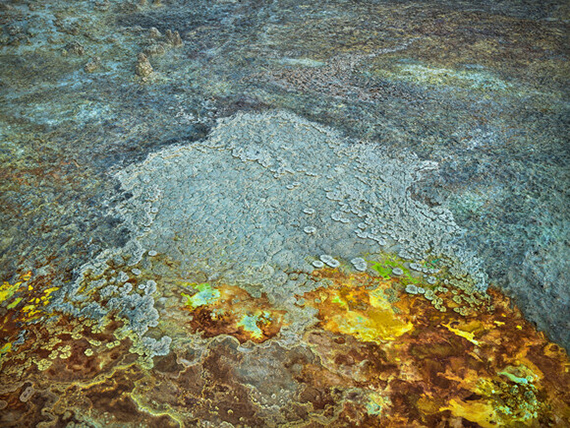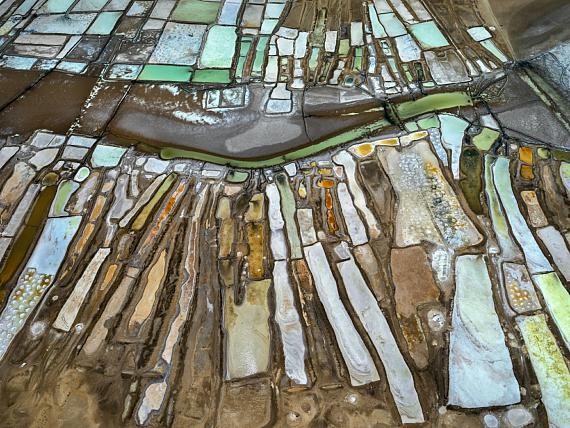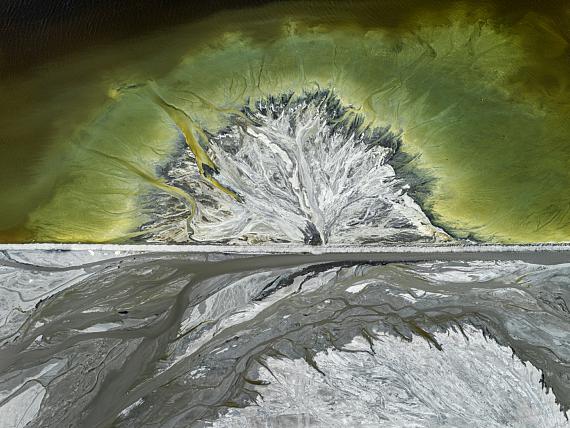
Sulfur Springs #2, Dallol, Danakil Depression, Ethiopia, 2018
From the series African Studies
Archival pigment print
122 x 163 cm
Edition of 6
Edward Burtynsky »
AFRICAN STUDIES
Exhibition: 7 Nov 2023 – 2 Mar 2024

Galerie Springer Berlin
Fasanenstr. 13
10623 Berlin
+49 (0)30-3157220
office@galeriespringer.de
www.galeriespringer.de
Tue-Fri 12-18, Sa 12-15 +

Sand Dunes #3, Sossusvlei, Namib Desert, Namibia, 2018
From the series African Studies
Archival pigment print
100 x 132 cm
Edition of 9
Edward Burtynsky
"AFRICAN STUDIES"
Exhibition: 7 November 2023 – 2 March 2024
Opening: Saturday, 4 November, 2 – 6 p.m.
The exhibition "African Studies" by Canadian photographer Edward Burtynsky is the fourth solo exhibition by this internationally renowned artist since 2014 at Galerie Springer Berlin.
For decades, his concern for the environment has been the driving force behind his artistic work. In stunningly beautiful images, he shows us the serious marks that industry leaves on the earth. At the same time, his images often document alarming ecological disasters.
For his new series "African Studies" he spent seven years travelling through ten countries in sub-Saharan Africa. He documents the continent's rapid industrialisation, probably the world's last great expansion.
The exhibition includes work from Ethiopia, Kenya, Namibia, Senegal and South Africa. The photographs show bird's eye views of the mining of sulphur, coal, iron, diamonds and salt. Breathtaking images from Namibia reveal the beauty of the country's unspoilt nature.
The same-titled book was recently issued by Steidl Verlag in the fall of 2022.
"My interest in Africa owes its genesis to an earlier body of work that I produced about China back
in 2004. For that project, and while researching several topics including the Three Gorges Dam, urban
renewal, and recycling, I learned how the new Chinese factories were being created. At the time,
heavy machinery was literally being unbolted from concrete floors in Europe and North America,
then shipped and refastened to the floors of gigantic facilities in China. This represented a paradigm
shift of industry, and it seemed obvious that China was rapidly becoming a leading manufacturer for
the world. I realized even then that the African continent was poised to become the next, perhaps
even the last, territory for major industrial expansion.
Two decades later, globalism has indeed rapidly evolved. In 2016, China’s general assembly presented
a new vision for their country, announcing boldly that they wanted to create tens of millions of
offshore manufacturing jobs over the next decade in order to move China towards becoming a service
economy. The governing bodies considered several key issues, among them: concern about the
degree of air and water pollution that domestic industrial activity was inflicting on the homeland,
and that demand for wage increases was consequently increasing production costs to substantially
higher levels than could be afforded in countries such as Bangladesh, Vietnam, Indonesia and in numerous
countries within Africa. Another consideration, which was tied to the now defunct one-child
policy; there was also an over-abundant population of young Chinese men and finding work abroad
for them would help deal with this imbalance.
Across Africa, as with most other places in the developed and developing world, far too great a price
is paid by its fauna, forests and Indigenous peoples. With this project I hope to continue raising awareness
about the cost of growing our civilization without the necessary consideration for sustainable
industrial practices, and the dire need for implementing globally organized governmental initiatives,
with binding international legislations, in order to protect present and future generations from what
stands to be forever lost.
Homo sapiens began migrating out of Africa as early as 200,000 years ago. Fast-forward to the 21st
century and we’ve come full circle, returning to one of the last places on Earth to be swept into the
unrelenting machinations of the human industrial complex. With our ever-increasing population and
requisite appetite for unlimited economic and technological expansion, the African continent, boasting
a tremendous wealth of unexploited resources, is a fragile, final frontier — resting squarely in
the crosshairs of progress.
Edward Burtynsky, extract from the book "African Studies", Steidl Verlag 2022

Salt Ponds #6, Near Tikat Banguel, Senegal, 2019
From the series African Studies
Archival pigment print
149 x 198 cm
Edition of 3
Edward Burtynsky
"AFRICAN STUDIES"
Ausstellung: 7. November 2023 bis 2. März 2024
Eröffnung: Samstag, 4. November, 14 - 18 Uhr
Die Ausstellung "African Studies" des kanadischen Fotografen Edward Burtynsky ist bereits die vierte Einzelausstellung des international renommierten Künstlers seit 2014 in der Galerie Springer Berlin.
Burtynskys künstlerisches Schaffen ist seit Jahrzehnten von der Sorge um die Umwelt
geprägt. In faszinierend schönen Bildern zeigt er die gravierenden Spuren, die die Industrie auf der
Erde hinterlässt. Gleichzeitig dokumentieren seine Bilder oft erschreckende Umweltkatastrophen
und deren Folgen.
Für seine neue Serie African Studies bereiste Edward Burtynsky sieben Jahre lang zehn Länder südlich
der Sahara. Er dokumentiert die rasante Industrialisierung des Kontinents, die wohl letzte große
Expansion der Welt.
Die Ausstellung zeigt Arbeiten aus Äthiopien, Kenia, Namibia, Senegal und Südafrika. Die Bilder zeigen
den Abbau von Schwefel, Kohle, Eisen, Diamanten und Salz aus der Vogelperspektive. Daneben
führen uns atemberaubende Bilder aus Namibia in die Schönheit der teils noch unberührten Natur.
Das gleichnamige Buch ist im Herbst 2022 im Steidl Verlag erschienen.
Mein Interesse an Afrika geht auf eine frühere Werkgruppe zurück, die ich 2004 über China gemacht
habe. Im Rahmen dieses Projekts und meiner Recherchen zu verschiedenen Themen, wurde
ich auf den Bau neuer chinesischer Fabriken aufmerksam. Schon damals vermutete ich, dass der
afrikanische Kontinent das nächste, vielleicht sogar das letzte große industrielle Expansionsgebiet
sein würde. Zwei Jahrzehnte später hat sich die Globalisierung in der Tat rasant weiterentwickelt.
In ganz Afrika, wie auch in den meisten anderen Teilen der entwickelten und sich entwickelnden
Welt, geschieht dieser Wandel auf Kosten der Fauna, der Wälder und die indigenen Völker, die dafür
einen viel zu hohen Preis bezahlen. Mit diesem Projekt hoffe ich, das Bewusstsein für die Kosten des
Wachstums unserer Zivilisation ohne die notwendige Berücksichtigung nachhaltiger industrieller
Praktiken zu schärfen und die dringende Notwendigkeit global organisierter Regierungsinitiativen
mit verbindlichen internationalen Gesetzen aufzuzeigen, um heutige und zukünftige Generationen
vor dem zu schützen, was für immer verloren zu gehen droht.
Vor 200.000 Jahren begann der Homo sapiens, Afrika zu verlassen. Im 21. Jahrhundert schließt sich
der Kreis: Wir kehren an einen der letzten Orte der Erde zurück, der den unerbittlichen Machenschaften
des menschlichen Industriekomplexes zum Opfer gefallen ist. Mit unserer ständig wachsenden
Bevölkerung und dem notwendigen Appetit auf grenzenlose wirtschaftliche und technologische
Expansion ist der afrikanische Kontinent mit seinem enormen Reichtum an unerschlossenen
Ressourcen eine fragile, letzte Grenze im Fadenkreuz des Fortschritts.
Statement Edward Burtynsky, Auszüge aus dem Buch "African Studies", Steidl Verlag, 2022

Coal Tailings #1, SASOL Synfuels, Secunda, Mpumalanga, South Africa, 2018
From the series African Studies
Archival pigment print
100 x 132 cm
Edition of 9